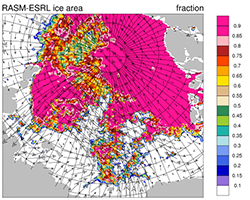Experimental Sea Ice Forecasting Products Updated for 2016 Fall Freeze-Up

August 29, 2016
The Physical Sciences Laboratory (PSL) has created new forecast guidance products and redesigned the web interface for the Experimental Sea Ice Forecasting page in response to input from partners at the National Weather Service (NWS) Alaska Region Sea Ice Program (SIP). The website is updated daily with 0-10 day forecast output, as well as model validation and skill results from 2015 and 2016. Forecasts will be posted from mid-August through early November 2016 to capture the September minimum extent through the critical freeze-up season transition.
RASM-ESRL—a modified version of an existing coupled ice-ocean-atmosphere model called the Regional Arctic System Model (RASM; Maslowski et al. 2012)—was developed for PSL weather-scale, sea ice research and forecast goals. The PSL Sea Ice Forecasting Team issued their first experimental forecasts for testing with NWS SIP during the 2015 fall freeze-up season. All components of the RASM-ESRL model have been updated for the 2016 freeze-up forecast season, most notably the ocean model which is now the dynamical Parallel Ocean Model (POP). Hindcasts run with this updated coupled system are currently being verified with observations obtained during the SeaState Arctic cruise, which was deployed from September through November 2015, before being used for coupled ocean-ice-air process studies.
Working with partners at NWS Alaska Region and NCEP has provided the PSL team with unparalleled opportunities to compare model skill between RASM-ESRL and the NWS operational (uncoupled) model forecasts. Using RASM-ESRL allows PSL to provide input to NCEP on how different initialization fields or how different ocean treatments might affect forecast skill as NWS develops the Next Generation Global Prediction System (NGGPS). Interactions with NWS Sea Ice Program forecasters gives PSL valuable insight into their work processes and the products they use for guidance and decision-making.
Contacts for More Information
- Janet Intrieri, a NOAA researcher at PSL
- Amy Solomon, a CIRES researcher at PSL
